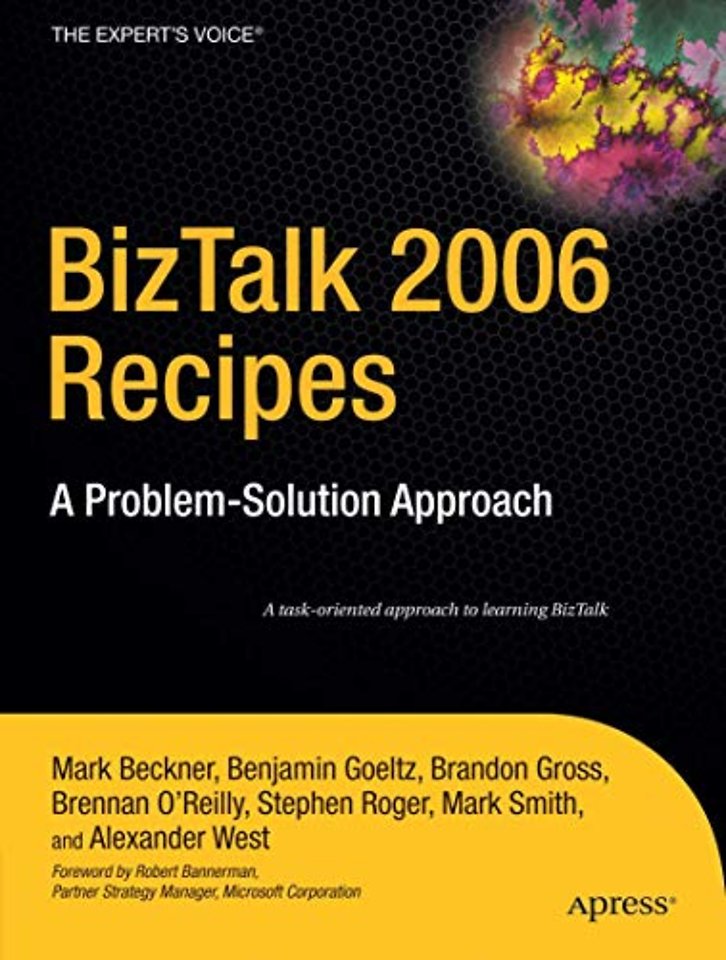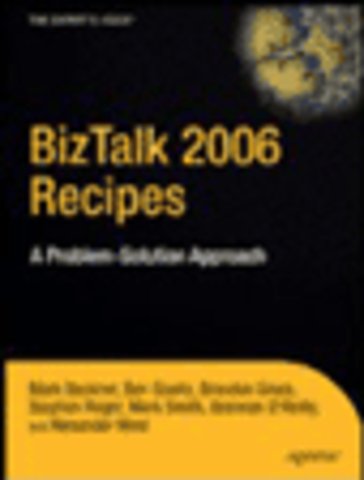


After being lost in the desert for a period of years, bearded, unwashed, and resembling a nineteenth century politician, Mark Beckner found himself holding a degree in Computer Science and Information Systems from a small college in southwestern Colorado.
Meer over de auteursBizTalk 2006 Recipes: A Problem-Solution Approach
A task-oriented approach to learning BizTalk
Samenvatting
'BizTalk 2006 Recipes: A Problem-Solution Approach' is based on the experiences of many of the most prominent experts in the field. It features over 170 problem-solving recipes for BizTalk developers and administrators.
BizTalk Server 2006 builds on the heritage and core architecture of BizTalk Server 2004, leading to a powerful tool that encompasses the latest Microsoft technologies and industry standards for automating and managing business processes. BizTalk Server 2006 adds incremental value to BizTalk 2004 by improving administration, deployment, and other key areas of the product.
Specificaties
Over Benjamin Goeltz
Over Brandon Gross
Inhoudsopgave
About the Foreword Author
About the Authors
About the Technical Reviewer
Acknowledgments
Introduction
1. Document Schemas
1-1. Creating Simple Document Schemas
1-2. Creating Schema Namespaces
1-3. Promoting Properties
1-4. Creating Property Schemas
1-5. Importing Schemas
1-6. Referencing Schemas
1-7. Creating Envelopes
1-8. Creating Complex Types
1-9. Defining Regular Expressions
1-10. Creating Flat File Schemas
1-11. Creating SOAP Header Schemas
2. Document Mapping
2-1. Creating Simple Maps
2-2. Organizing Maps
2-3. Adding Mapping Constants
2-4. Mapping Any Element Nodes
2-5. Using the Value Mapping Functoid
2-6. Using the Mass Copy Functoid
2-7. Using the Table Looping Functoid
2-8. Using the Database Lookup Functoid .
2-9. Seeding Cross-Reference Tables with ID Cross-References
2-10. Seeding Cross-Reference Tables with Value Cross-References
2-11. Using the ID Cross-Reference Functoids
2-12. Using the Value Cross-Reference Functoids
2-13. Using the Looping Functoid
2-14. Using the Iteration Functoid
2-15. Creating a Custom Functoid
2-16. Using the Date and Time Functoids
2-17. Creating Functoid If-Then-Else Logic
2-18. Calling Compiled Assemblies
2-19. Using Inline C#
2-20. Passing Orchestration Variables into Maps
2-21. Using Inline XSLT
2-22. Using Call Templates
2-23. Using XSLT Group-By
2-24. Testing Maps
3. Messaging
3-1. Configuring Receive Ports and Locations
3-2. Configuring Send Ports
3-3. Configuring Port Maps
3-4. Using Send Port Groups
3-5. Creating Validation Pipelines
3-6. Creating Encryption Pipelines
3-7. Creating Flat File Send and Receive Pipelines
3-8. Creating Custom Pipeline Components
3-9. Handling Pipeline Errors
4. Orchestration
4-1. Receiving Messages
4-2. Sending Messages
4-3. Creating Multipart Messages
4-4. Binding Orchestrations
4-5. Configuring a Send Port at Runtime
4-6. Creating Branching Logic in an Orchestration
4-7. Receiving Multiple Message Formats in a Single Orchestration
4-8. Calling External Assemblies
4-9. Receiving Untyped Messages
4-10. Using the Parallel Action Shape
4-11. Using the Loop Shape
4-12. Using the Transform Shape
4-13. Using the Call Orchestration and Start Orchestration Shapes
4-14. Configuring Basic Correlations
4-15. Maintaining Message Order
4-16. Configuring Parallel Convoys
4-17. Using XPath Queries on Messages
4-18. Using Nontransactional Orchestration Scopes
4-19. Creating Atomic Scopes
4-20. Using Long-Running Transactions
4-21. Catching Exceptions Consistently
4-22. Creating Role Links
4-23. Calling Web Services
4-24. Exposing an Orchestration As a Web Service
5. Business Rules Framework
5-1. Creating a Business Policy
5-2. Creating and Testing Rules
5-3. Creating Facts
5-4. Setting Rule Priorities
5-5. Creating Custom Fact Retrievers
5-6. Calling the Business Rules Engine from .NET
5-7. Calling the Business Rules Engine from an Orchestration
5-8. Deploying and Undeploying Policies
6. Adapters
6-1. Configuring File Sends
6-2. Configuring File Receives
6-3. Configuring SMTP Send Ports
6-4. Configuring MSMQ Sends
6-5. Configuring MSMQ Receives
6-6. Sending Updategrams with the SQL Adapter
6-7. Calling Stored Procedures Using the SQL Adapter
6-8. Receiving with the SQL Adapter
6-9. Configuring HTTP Sends
6-10. Configuring HTTP Receives
6-11. Configuring SOAP Sends and Receives
7. Deployment
7-1. Exporting Applications
7-2. Importing Applications
7-3. Deploying a BizTalk Solution from Visual Studio
7-4. Enlisting and Starting Send Ports
7-5. Enabling Receive Locations
7-6. Enlisting and Starting Orchestrations
8. Administration and Operations
8-1. Troubleshooting Suspended Services
8-2. Finding a Message
8-3. Resubmitting Messages
8-4. Managing BizTalk Applications
8-5. Debugging Orchestrations
8-6. Tracking Messages
9. Business Activity Monitoring
9-1. Creating BAM Activities and Views
9-2. Deploying BAM Activities and Views
9-3. Using the BAM Portal
9-4. Setting Up BAM Alerts
9-5. Using the BAM Interceptor
9-6. Creating a BAM Service Request
9-7. Creating a Tracking Profile
10. Encore: BizTalk Server 2006
10-1.Working with the Flat File Schema Wizard
10-2. Using the Windows SharePoint Services Adapter
10-3. Subscribing to Suspended Messages
10-4. Using the POP3 Adapter
10-5. Calling Pipelines from Within an Orchestration
10-6. Resuming Inbound Message Processing
INDEX
Anderen die dit boek kochten, kochten ook
Net verschenen
Rubrieken
- aanbestedingsrecht
- aansprakelijkheids- en verzekeringsrecht
- accountancy
- algemeen juridisch
- arbeidsrecht
- bank- en effectenrecht
- bestuursrecht
- bouwrecht
- burgerlijk recht en procesrecht
- europees-internationaal recht
- fiscaal recht
- gezondheidsrecht
- insolventierecht
- intellectuele eigendom en ict-recht
- management
- mens en maatschappij
- milieu- en omgevingsrecht
- notarieel recht
- ondernemingsrecht
- pensioenrecht
- personen- en familierecht
- sociale zekerheidsrecht
- staatsrecht
- strafrecht en criminologie
- vastgoed- en huurrecht
- vreemdelingenrecht





